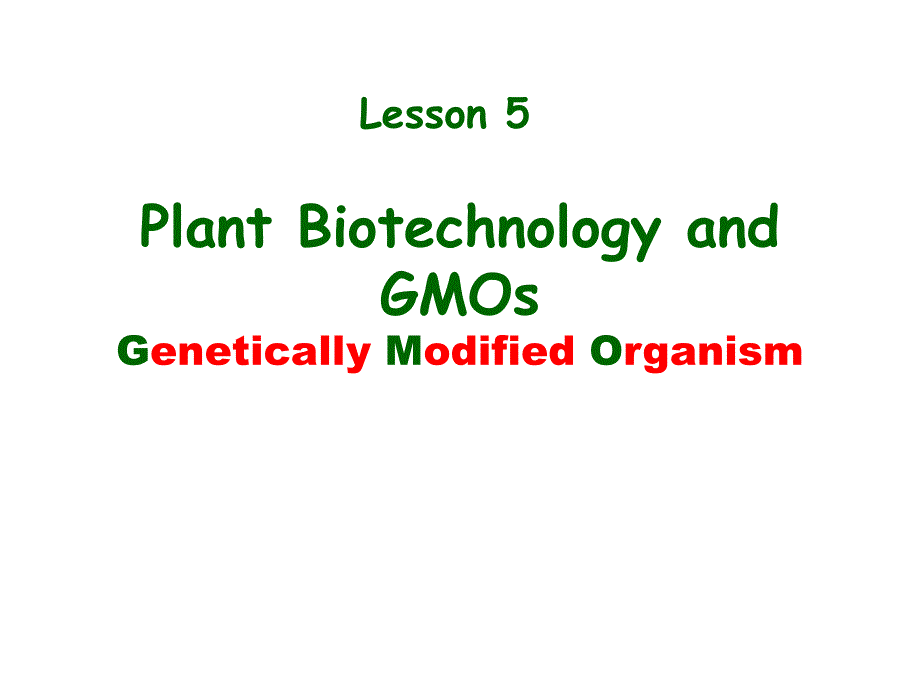 园艺专业英语课件:Lesson 5 Plant Biotechnology and GMOs
园艺专业英语课件:Lesson 5 Plant Biotechnology and GMOs



《园艺专业英语课件:Lesson 5 Plant Biotechnology and GMOs》由会员分享,可在线阅读,更多相关《园艺专业英语课件:Lesson 5 Plant Biotechnology and GMOs(69页珍藏版)》请在装配图网上搜索。
1、Plant Biotechnology and GMOsLesson 5Genetically Modified OrganismBlue roseA blue rose is a flower of the genus Rosa(family Rosaceae)that presents blue-to-violet pigmentation instead of the more common red,white,or yellow.Blue roses are often portrayed in literature and art as a symbol of love and pr
2、osperity to those who seek it,but do not exist in nature as a result of genetic limitations.Blue rose-artificially colouredSince they do not exist in nature as roses lack the specific gene that has the ability to produce a“true blue”color,Blue roses are traditionally created by dyeing white roses.No
3、minal blue roses have been bred by conventional hybridization methods,but the results,such as Blue Moon are more accurately described as being lilac in color.Blue Moon RosesBlue moon roses are unusually colored roses that were initially introduced to the world in 1965.The roses are not an authentic
4、blue,and resemble more of a pale lilac color instead.They are hybrid tea roses and are part of the Rosa genus.Blue moon roses are characterized by their long stems and are larger than many other varieties of roses,with raised centers.They are highly fragrant with scents that are similar to sweet tea
5、.These roses bloom from summer all the way into autumn.Delphinidin,the primary plant pigment that produces a blue hue but is not found naturally in roses.Rosa Cardinal de Richelieu rose,used for the first genetic engineering experimentsThe Blue Rose was developed by Suntory Flowers Prices were from
6、2,000 to 3,000 Yen or US$22 to 35 a stemIncreasing crop yieldsTo feed the increasing population we have to increase crop yields.Fertilizers-are compounds to promote growth;usually applied either via the soil,for uptake by plant roots,or by uptake through leaves.Can be organic or inorganicHave caused
7、 many problems!Algal blooms pollute lakes near areas of agriculture Increasing crop yieldsAlgalblooms-arelativelyrapidincreaseinthepopulationof(usually)phytoplanktonalgaeinanaquaticsystem.Causesthedeathoffishanddisruptiontothewholeecosystemofthelake.Internationalregulationshasledtoareductionintheocc
8、urrencesoftheseblooms.Chemical pest controlEachyear,30%ofcropsarelosttoinsectsandothercroppests.Theinsectsleavelarva,whichdamagetheplantsfurther.Fungidamageorkillafurther25%ofcropplantseachyear.Anysubstancethatkillsorganismsthatweconsiderundesirableareknownasapesticide.Anidealpesticidewould:Killonly
9、thetargetspeciesHavenoeffectonthenon-targetspeciesAvoidthedevelopmentofresistanceBreakdowntoharmlesscompoundsafterashorttimeChemical pest controlDDTwasfirstdevelopedinthe1930sVeryexpensive,toxictobothharmfulandbeneficialspeciesalike.Over400insectspeciesarenowDDTresistant.Aswithfertilizers,thereareru
10、n-offproblems.Affectsthefoodpyramid.PersistintheenvironmentChemical pest controlDDTpersistsinthefoodchain.Itconcentratesinfishandfish-eatingbirds.Interferewithcalciummetabolism,causingathinningintheeggslaidbythebirdsbreakbeforeincubationisfinisheddecreaseinpopulation.AlthoughDDTisnowbanned,itisstill
11、usedinsomepartsoftheworld.Plant BiotechnologyTheuseoflivingcellstomakeproductssuchaspharmaceuticals,foods,andbeveragesTheuseoforganismssuchasbacteriatoprotecttheenvironmentTheuseofDNAsciencefortheproductionofproducts,diagnostics,andresearchPlant Biotechnology“For centuries,humankind has made improve
12、ments to crop plants through selective breeding and hybridization the controlled pollination of plants.Plant biotechnology is an extension of this traditional plant breeding with one very important difference plant biotechnology allows for the transfer of a greater variety of genetic information in
13、a more precise,controlled manner.”Genetically modified cropsAllplantcharacteristics,suchassize,texture,andsweetness,aredeterminedonthegeneticlevel.Also:Thehardinessofcropplants.Theirdroughtresistance.Rateofgrowthunderdifferentsoilconditions.Dependenceonfertilizers.Resistancetovariouspestsanddiseases
14、.UsedtodothisbyselectivebreedingWhy would we want to modify an organism?Bettercropyield,especiallyunderharshconditions.HerbicideordiseaseresistanceNutritionorpharmaceuticals,vaccinedeliveryOrnamentalpurposeWhats your opinion on GM food?Genetically modified foodslGenetically modified foods(or GM food
15、s)are foods produced from organisms that have had specific changes introduced into their DNA using the methods of genetic engineering.lThese techniques have allowed for the introduction of new crop traits as well as a far greater control over a foods genetic structure than previously afforded by met
16、hods such as selective breeding and mutation breeding.lCommercial sale of genetically modified foods began in 1994,when Calgene first marketed its Flavr Savr delayed ripening tomato.lTo date most genetic modification of foods have primarily focused on cash crops in high demand by farmers such as soy
17、bean,corn,canola,and cotton seed oil.lThese have been engineered for resistance to pathogens and herbicides and better nutrient profiles.lGM livestock have also been experimentally developed,although as of November 2013 none are currently on the market.But a GM salmon was awaiting regulatory approva
18、l at that time.lThere is broad scientific consensus that food on the market derived from GM crops poses no greater risk to human health than conventional food.lHowever,opponents have objected to GM foods on several grounds,including safety issues,environmental concerns,and economic concerns raised b
19、y the fact that GM seeds(and potentially animals)that are food sources are subject to intellectual property rights owned by multinational corporations.Roundup Ready GeneTheglyphosateresistancegeneprotectsfoodplantsagainstthebroad-spectrumherbicideGlyphosate-N-(phosphonomethyl)glycineRoundup,whicheff
20、icientlykillsinvasiveweedsinthefield.ThemajoradvantagesoftheRoundupReady”systemincludebetterweedcontrol,reductionofcropinjury,higheryield,andlowerenvironmentalimpactthantraditionalweedcontrolsystems.Notably,fieldstreatedwithRounduprequirelesstilling;thispreservessoilfertilitybylesseningsoilrun-offan
21、doxidation.”Glyphosate-N-(phosphonomethyl)glycineAnaminophosphonicanalogueofthenaturalaminoacidglycine.Itisabsorbedthroughfoliageandtranslocatedtoactivelygrowingpoints.(Meristems!)Modeofactionistoinhibitanenzymeinvolvedinthesynthesisofthearomaticaminoacids:tyrosine,tryptophanphenylalanineGlyphosateG
22、lycineGlyphosate-N-(phosphonomethyl)glycineItdoesthisbyinhibitingtheenzyme5-enolpyruvylshikimate-3-phosphatesynthase(EPSPS),whichcatalyzesthereactionofshikimate-3-phosphate(S3P)andphosphoenolpyruvatetoform5-enolpyruvylshikimate-3-phosphate(ESP).ESPsubsequentlydephosphorylatedtochorismate,anessential
23、precursorinplantsforthesearomaticaminoacids.GlyphosateGlycineRoundup Ready GeneGlyphosatefunctionsbyoccupyingthebindingsiteofthephosphoenolpyruvate,mimickinganintermediatestateoftheenzymesubstratescomplex.TheRoundupReady”systemintroducesastablegenealterationwhichpreventsGlyphosatebindingandallowingt
24、heformationoftheessentialaromaticaminoacidsRoundup Ready GeneTheshikimatepathwayisnotpresentinanimals,whichinsteadobtainaromaticaminoacidsfromtheirdiet.GlyphosatehasalsobeenshowntoinhibitotherplantenzymesAlsohasbeenfoundtoaffectanimalenzymes.TheUnitedStatesEnvironmentalProtectionAgencyconsidersglyph
25、osatetoberelativelylowintoxicity,andwithoutcarcinogenicorteratogeniceffectsHowever,somefarmworkershavereportedchemicalburnsandcontactskinburnsEnvironmental degradationWhenglyphosatecomesintocontactwiththesoil,itcanberapidlyboundtosoilparticlesandbeinactivated.Unboundglyphosatecanbedegradedbybacteria
26、.However,glyphosatehasbeenshowntoincreasetheinfectionrateofwheatbyfusariumheadblightinfieldsthathavebeentreatedwithglyphosate.Insoils,half-livesvaryfromaslittleas3daysatasiteinTexasto141daysatasiteinIowa.Inaddition,theglyphosatemetaboliteaminomethylphosphonicacidhasbeenshowntopersistupto2yearsinSwed
27、ishforestsoils.Glyphosateabsorptionvariesdependingonthekindofsoil.Insect ResistanceB.thuringiensis(commonly known as Bt)is an insecticidal bacterium,marketed worldwide for control of many important plant pests-mainly caterpillars of the Lepidoptera(butterflies and moths)but also mosquito larvae,and
28、simuliid blackflies that vector river blindness in Africa.Bt products represent about 1%of the total agrochemical market(fungicides,herbicides and insecticides)Genetically modified crops1992-Thefirstcommerciallygrowngeneticallymodifiedfoodcropwasatomato-wasmademoreresistanttorotting,byaddingananti-s
29、ensegenewhichinterferedwiththeproductionoftheenzymepolygalacturonase.Theenzymepolygalacturonasebreaksdownpartoftheplantcellwall,whichiswhathappenswhenfruitbeginstorot.Genetically modified cropsNeed to build in a:PromoterStop signal CODING SEQUENCE5 UTRpoly A signalPROMOTERON/OFF SwitchMakes Proteins
30、top signGenetically modified cropsSotomodifyaplant:NeedtoknowtheDNAsequenceofthegeneofinterestNeedtoputaneasilyidentifiablemakergenenearornexttothegeneofinterestHavetoinsertbothoftheseintotheplantnucleargenomeGoodscreenprocesstofindsuccessfulinsertionCODING SEQUENCEINTRONpoly A signalPROMOTERBuildin
31、g the TransgenesPlant Transgenebacterial genesantibiotic markerreplication originPlant Selectable Marker GenePlasmid DNA ConstructON/OFF SwitchMakes Proteinstop signCloning into a PlasmidTheplasmidcarryinggenesforantibioticresistance,andaDNAstrand,whichcontainsthegeneofinterest,arebothcutwiththesame
32、restrictionendonuclease.TheplasmidisopenedupandthegeneisfreedfromitsparentDNAstrand.Theyhavecomplementarystickyends.TheopenedplasmidandthefreedgenearemixedwithDNAligase,whichreformsthetwopiecesasrecombinantDNA.Cloning into a PlasmidPlasmids+copiesoftheDNAfragmentproducequantitiesofrecombinantDNA.Thi
33、srecombinantDNAstewisallowedtotransformabacterialculture,whichisthenexposedtoantibiotics.AllthecellsexceptthosewhichhavebeenencodedbytheplasmidDNArecombinantarekilled,leavingacellculturecontainingthedesiredrecombinantDNA.So,how do you get the DNA into the Plant?Meristems InjectionsREMEMBER!Thetissue
34、inmostplantsconsistingofundifferentiatedcells(meristematiccells),foundinzonesoftheplantwheregrowthcantakeplace.Meristematiccellsareanalogousinfunctiontostemcellsinanimals,areincompletelyornotdifferentiated,andarecapableofcontinuedcellulardivision.FirstmethodofDNAtransfertoaplant.InjectDNAintothetipc
35、ontainingthemostundifferentiatedcellsmorechanceofDNAbeingincorporatedinplantGenomeWorkedabout1in10,000times!Tunica-Corpusmodeloftheapicalmeristem(growingtip).Theepidermal(L1)andsubepidermal(L2)layersformtheouterlayerscalledthetunica.TheinnerL3layeriscalledthecorpus.CellsintheL1andL2layersdivideinasi
36、dewaysfashionwhichkeepstheselayersdistinct,whiletheL3layerdividesinamorerandomfashion.Particle BombardmentParticle-GunBombardment1.DNA-orRNA-coatedgold/tungstenparticlesareloadedintothegunandyoupullthetrigger.SelectedDNAstickstosurfaceofmetalpelletsinasaltsolution(CaCl2).Particle Bombardment2.Alowpr
37、essureheliumpulsedeliversthecoatedgold/tungstenparticlesintovirtuallyanytargetcellortissue.3.TheparticlescarrytheDNAcellsdonothavetoberemovedfromtissueinordertotransformthecells4.Asthecellsrepairtheirinjuries,theyintegratetheirDNAintotheirgenome,thusallowingforthehostcelltotranscribeandtranslatethet
38、ransgene.Particle BombardmentTheDNAsometimeswasincorporatedintothenucleargenomeoftheplantGenehastobeincorporatedintocellsDNAwhereitwillbetranscribedAlsoinsertedgenemustnotbreakupsomeothernecessarygenesequenceParticle BombardmentAgrobacterium tumefaciensOverall processUsesthenaturalinfectionmechanism
39、ofaplantpathogenAgrobacterium tumefaciensnaturally infectsthewoundsitesindicotyledonousplantcausingtheformationofthecrowngalltumors.CapabletotransferaparticularDNAsegment(T-DNA)ofthetumor-inducing(Ti)plasmidintothenucleusofinfectedcellswhereitisintegratedfullyintothehostgenomeandtranscribed,causingt
40、hecrowngalldisease.SothepathogeninsertsthenewDNAwithgreatsuccess!Overall processThevirregionontheplasmidinsertsDNAbetweentheT-regionintoplantnucleargenomeInsertgeneofinterestandmarkerintheT-regionbyrestrictionenzymesthepathogenwillthen“infect”theplantmaterialWorksfantasticallywellwithalldicotplantsp
41、eciestomatoes,potatoes,cucumbers,etcDoesnotworkaswellwithmonocotplantspecies-cornAsAgrobacterium tumefaciensdonotnaturallyinfectmonocotsOverview of the Infection Process1.Agrobacterium tumefacienschromosomalgenes:chvA,chvB,pscArequiredforinitialbindingofthebacteriumtotheplantcellandcodeforpolysaccha
42、rideonbacterialcellsurface.2.Virulenceregion(vir)carriedonpTi,butnotinthetransferredregion(T-DNA).GenescodeforproteinsthatpreparetheT-DNAandthebacteriumfortransfer.Ti plasmids and the bacterial chromosome act in concert to transform the plant3.T-DNAencodesgenesforopinesynthesisandfortumorproduction.
43、4.occ(opinecatabolism)genescarriedonthepTiandallowsthebacteriumtoutilizeopinesasnutrient.vir genesopine catabolismpTitrafor transfer to the plantbacterial conjugationAgrobacterium chromosomal DNAchvA chvBpscAoriVT-DNA-inserts into plant genomeAgrobacterium tumafaciens senses Acetosyringone via a 3-c
44、omponent-like system 3 components:ChvE,VirA,VirGPeriplasmicdomainacetosyringoneChvEVirAVirGsugarsTransmitterInhibitorydomainreceiverDNA-binding1.ChvEperiplasmicproteinbindstosugars,arabinose,glucosebindstoVirAperiplasmicdomainamplifiesthesignalPeriplasmicdomainacetosyringoneChvEVirAVirGsugarsTransmi
45、tterInhibitorydomainreceiverDNA-binding2.VirA:Receptor kinase1.Membraneproteinfivefunctionaldomains:a)PeriplasmicbindsChvE-sugarcomplexdoesNOTbindacetosyringoneb)Transmembranedomainc)LinkerregionBINDSacetosyringoneNOTEthisisonthecytoplasmicside!PeriplasmicdomainacetosyringoneChvEVirAVirGsugarsTransm
46、itterInhibitorydomainreceiverDNA-binding2.VirA:Receptor kinased)Transmitterdomain(His)auto-phosphorylatesandthentransferstotheresponseregulatorproteinVirGe)InhibitorydomainwillbleedoffthephosphatefromtheHisinthetransmitterdomain(toanAsp)Periplasmic domainacetosyringoneChvEVirAVirGsugarsTransmitterIn
47、hibitory domainreceiverDNA-binding3.VirG:Response Regulatora)ReceiverdomainthatisphosphorylatedonanAspresiduebytheHisonthetransmitterdomainofVirAb)ActivatestheDNAbindingdomaintopromotetranscriptionfromVir-boxcontinaingpromotersequences(ontheTiplasmid)PeriplasmicdomainacetosyringoneChvEVirAVirGsugars
48、TransmitterInhibitorydomainreceiverDNA-bindingAgrobacterium can be used to transfer DNA into plantsAgrobacteria arebiologicalvectorsforintroductionofgenesintoplants.Agrobacteriaattachtoplantcellsurfacesatwoundsites.Theplantreleaseswoundsignalcompounds,suchasacetosyringone.ThesignalbindstovirAontheAg
49、robacteriummembrane.VirAwithsignalboundactivatesvirG.SummaryActivatedvirGturnsonothervirgenes,includingvir DandE.virDcutsataspecificsiteintheTiplasmid(tumor-inducing),theleftborder.Theleftborderandasimilarsequence,therightborder,delineatetheT-DNA,theDNAthatwillbetransferredfromthebacteriumtotheplant
50、cellSinglestrandedT-DNAisboundbyvirEproductastheDNAunwindsfromthevirDcutsite.Bindingandunwindingstopattherightborder.SummaryTheT-DNAistransferredtotheplantcell,whereitintegratesinnuclearDNA.T-DNAcodesforproteinsthatproducehormonesandopines.Hormonesencouragegrowthofthetransformedplanttissue.Opinesfee
51、dbacteriaacarbonandnitrogensource.SummaryOverview of the Infection ProcessAnd then?.What is the last step?.Tissue cultureThe basics!What is Plant Tissue Culture?Ofallthetermswhichhavebeenappliedtotheprocess,micropropagationisthetermwhichbestconveysthemessageofthetissueculturetechniquemostwidelyinuse
52、today.Theprefixmicrogenerallyreferstothesmallsizeofthetissuetakenforpropagation,butcouldequallyrefertothesizeoftheplantswhichareproducedasaresult.ReliesontwoplanthormonesAuxinCytokininProtoplast to Plant Callus:Inducedby2,4dichlorphenoxyaceticacid(2,4-D)Unorganized,growingmassofcellsDedifferentiatio
53、nofexplantLooselyarrangedthinnedwalled,outgrowthsNopredictablesiteoforganizationordifferentiationAuxin(indoleacetic acid)Producedinapicalandrootmeristems,youngleaves,seedsindevelopingfruitscellelongationandexpansionsuppressionoflateralbudgrowthinitiationofadventitiousrootsstimulationofabscission(you
54、ngfruits)ordelayofabscissionhormoneimplicatedintropisms(photo-,gravi-)celldivisionfactorstimulatesadventitiousbudformationdelayssenescencepromotessomestagesofrootdevelopmentCytokinin(zeatin,ZR,IPA)Producedinrootmeristems,youngleaves,fruits,seedsOrganogenesisTheformationoforgansfromacallusRuleofthumb
55、:Auxin/cytokinin10:1-100:1inducesroots.1:10-1:100inducesshootsIntermediateratiosaround1:1favorcallusgrowth.Edible VaccinesTransgenic Plants Serving Human Health NeedsWorkslikeanyvaccineAtransgenicplantwithapathogenproteingeneisdevelopedPotato,banana,andtomatoaretargetsHumanseattheplantThebodyproducesantibodiesagainstpathogenproteinHumansare“immunized”againstthepathogenExamples:DiarrheaHepatitisBMeaslesThe End!Any Questions?
- 温馨提示:
1: 本站所有资源如无特殊说明,都需要本地电脑安装OFFICE2007和PDF阅读器。图纸软件为CAD,CAXA,PROE,UG,SolidWorks等.压缩文件请下载最新的WinRAR软件解压。
2: 本站的文档不包含任何第三方提供的附件图纸等,如果需要附件,请联系上传者。文件的所有权益归上传用户所有。
3.本站RAR压缩包中若带图纸,网页内容里面会有图纸预览,若没有图纸预览就没有图纸。
4. 未经权益所有人同意不得将文件中的内容挪作商业或盈利用途。
5. 装配图网仅提供信息存储空间,仅对用户上传内容的表现方式做保护处理,对用户上传分享的文档内容本身不做任何修改或编辑,并不能对任何下载内容负责。
6. 下载文件中如有侵权或不适当内容,请与我们联系,我们立即纠正。
7. 本站不保证下载资源的准确性、安全性和完整性, 同时也不承担用户因使用这些下载资源对自己和他人造成任何形式的伤害或损失。
最新文档
- 专题党课讲稿:以高质量党建保障国有企业高质量发展
- 廉政党课讲稿材料:坚决打好反腐败斗争攻坚战持久战总体战涵养风清气正的政治生态
- 在新录用选调生公务员座谈会上和基层单位调研座谈会上的发言材料
- 总工会关于2025年维护劳动领域政治安全的工作汇报材料
- 基层党建工作交流研讨会上的讲话发言材料
- 粮食和物资储备学习教育工作部署会上的讲话发言材料
- 市工业园区、市直机关单位、市纪委监委2025年工作计划
- 检察院政治部关于2025年工作计划
- 办公室主任2025年现实表现材料
- 2025年~村农村保洁员规范管理工作方案
- 在深入贯彻中央8项规定精神学习教育工作部署会议上的讲话发言材料4篇
- 开展深入贯彻规定精神学习教育动员部署会上的讲话发言材料3篇
- 在司法党组中心学习组学习会上的发言材料
- 国企党委关于推动基层党建与生产经营深度融合工作情况的报告材料
- 副书记在2025年工作务虚会上的发言材料2篇
